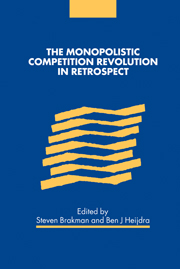Book contents
- Frontmatter
- Contents
- List of contributors
- Preface
- 1 Introduction
- Part I Underground classics
- Part II Current Perspectives
- Part III International trade
- Part IV Economic geography
- Part V Economic growth
- 14 Monopolistic competition and economic growth
- 15 Convergence and the welfare gains of capital mobility in a dynamic Dixit–Stiglitz world
- 16 A vintage model of technology diffusion: the effects of returns to diversity and learning-by-using
- Part VI Macroeconomics
- Index
16 - A vintage model of technology diffusion: the effects of returns to diversity and learning-by-using
Published online by Cambridge University Press: 22 September 2009
- Frontmatter
- Contents
- List of contributors
- Preface
- 1 Introduction
- Part I Underground classics
- Part II Current Perspectives
- Part III International trade
- Part IV Economic geography
- Part V Economic growth
- 14 Monopolistic competition and economic growth
- 15 Convergence and the welfare gains of capital mobility in a dynamic Dixit–Stiglitz world
- 16 A vintage model of technology diffusion: the effects of returns to diversity and learning-by-using
- Part VI Macroeconomics
- Index
Summary
Introduction
A good understanding of well-documented differences in growth and productivity performance of different countries requires an understanding of the complex process of the development and diffusion of new technologies. Relatively much effort – for example, in the recent new or endogenous growth theory – has been devoted to endogenising the rate of arrival of new technologies emphasising the importance of R&D and human capital (e.g. Lucas, 1988; Grossman and Helpman, 1991). However, a good understanding of the diffusion and adoption of new technologies is in our view at least equally important (see, for example, Jovanovic, 1997). In this regard, we know that diffusion of new technologies is a lengthy process, that adoption of new technologies is costly and that many firms continue to invest in old and (seemingly) inferior technologies. The relevance of the latter phenomenon has, for example, convincingly been shown in the literature on the so-called energy-efficiency paradox; the phenomenon that firms do not (exclusively) invest in technologies that according to standard net present-value (NPV) calculations yield the highest return (see, for example, Sutherland, 1991; Howarth and Andersson, 1993; Jaffe and Stavins, 1994). The aim of this chapter is to contribute to our understanding of adoption behaviour of firms and of diffusion processes of new technologies.
The question as to why firms do not invest in seemingly superior technologies has already achieved much attention in the literature. We can categorise this literature into four groups.
- Type
- Chapter
- Information
- The Monopolistic Competition Revolution in Retrospect , pp. 356 - 372Publisher: Cambridge University PressPrint publication year: 2001
- 2
- Cited by



